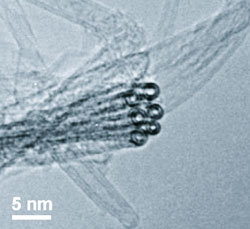Jul 24 2007
Carbon nanotubes have shown great promise for creating single-molecule biosensors for detecting disease, mostly a result of the fact that the electrical conductivity of a carbon nanotube changes markedly when they bind to specific molecules.
 An electron microscope image shows a bundle of nanotubes. Courtesy of Tobial Hertel, Ph.D., Vanderbilt University.
An electron microscope image shows a bundle of nanotubes. Courtesy of Tobial Hertel, Ph.D., Vanderbilt University.
But nanotubes also produce light with a number of interesting properties, which have led researchers to propose various optical applications using modified nanotubes. One of the most promising is to use the tiny tubes as fluorescent markers to study biological systems, a role served today by fluorescent proteins and quantum dots, but nanotubes have proven to be very inefficient at converting absorbed light into emitted light, absorbing a thousand photons for every photon that they emit (a ratio called quantum efficiency).
Now, however, the latest research into nanotube luminescence has found that there is substantial room for increasing the efficiency of these infinitesimal light sources: The study, conducted by researchers at Vanderbilt University and two institutions in Germany, is the first to measure the luminescence of single carbon nanotubes. The results of this research, published in the journal Physical Review Letters, show that there is a surprising amount of variation between the quantum efficiencies of the 15 individual nanotubes that the researchers examined.
"We were expecting to see individual differences of only a few percent, so we were very surprised to find that some nanotubes are a 1,000 percent more efficient than others," says Tobias Hertel, Ph.D., of Vanderbilt University, who conducted the study with two German research groups based at the Siegen University and the Max Planck Institute.
Nanotubes, along with buckeyballs, are members of the fullerene family of carbon-based molecules. Nanotubes are seamless cylinders made of carbon atoms and capped on at least one end with a buckyball hemisphere. Nanotubes come in two basic forms: single-walled and multi-walled, which have two or more concentric shells. Slight differences in the geometric arrangement of carbon atoms produces nanotubes with different electrical properties, either metallic or semiconductor. Semiconducting nanotubes are the variety that produces light.
"Our analysis pinpoints structural defects [in the walls of a nanotube] as the source for most of the energy drain that reduces nanotubes' quantum efficiency as a light source. It should be possible to plug these energy sinks and improve their overall efficiency by a factor of five or so by improvements in the synthesis processes," Dr. Hertel says.
Although he doesn't know exactly what these improvements will be, Dr. Hertel is confident that they will happen. Improving nanotube synthesis is a big business.
"There are hundreds of research groups around the world who are working full time to improve nanotube synthesis," he reports. As a result, improvements in the various synthesis processes are reported regularly.
Even if improving the nanotube's quantum efficiency proves unexpectedly difficult, there are likely to be ways of working around this limitation. For example, another way to brighten nanotubes is to simply make them longer, the physicist points out.
Other research groups are already experimenting with the use of nanotubes as a replacement for fluorescent proteins in the study of biological systems. In this application, they are competing with another nanotechnology called quantum dots, which are tiny fluorescent beads often made of cadmium selenide. According to Dr. Hertel, nanotubes have several inherent advantages over quantum dots for this application. Nanotubes are not known to be toxic to living cells, unlike the cadmium found in quantum dots. They produce a narrower, more precise beam of light, too, which may make them easier to detect.
This work is detailed in a paper titled, “Exponential decay lifetimes of excitons in individual single-walled carbon nanotubes.” An abstract is available at the journal’s website. View abstract.